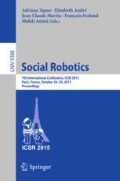Abstract
Remote presence systems that allow remote operators to physically move around the world, observe it, and, in some cases, manipulate it, introduce a new set of privacy concerns. Traditional telepresence systems allow remote users to passively observe, forcing them to look at whatever the camera is pointing at. If we want something to remain private, then we simply do not put it in front of the camera. Remote presence systems, on the other hand, allow active observation, and put the control of the camera in the hands of the remote operator. They can drive around, and look at the world from different viewpoints, which complicates privacy protection.
In this paper, we look at how we can establish privacy protections for remote presence systems by manipulating the video data sent back to them. We evaluate a number of manipulations of these data, balancing privacy protection against the ability to perform a given task, and report on the results of two studies that attempt to evaluate these techniques.
Preview
Unable to display preview. Download preview PDF.
References
Beam remote presence system. https://www.suitabletech.com/
VGo robotic telepresence for healthcare. http://www.vgocom.com/
Barnes, C., Shechtman, E., Finkelstein, A., Goldman, D.B.: Patchmatch: a randomized correspondence algorithm for structural image editing. ACM Trans. Graph. 28(3), 24:1–24:11 (2009)
Boyle, M., Edwards, C., Greenberg, S.: The effects of filtered video on awareness and privacy. In: CSCW 2000, pp. 1–10 (2000)
Boyle, M., Neustaedter, C., Greenberg, S.: Privacy factors in video-based media spaces. In: Media Space 20+ Years of Mediated Life. CSCW, pp. 97–122 (2009)
Edgcomb, A., Vahid, F.: Privacy perception and fall detection accuracy for in-home video assistive monitoring with privacy enhancements. SIGHIT Rec. 2(2), 6–15 (2012)
Eisemann, E., Winnemöller, H., Hart, J.C., Salesin, D.: Stylized vector art from 3D models with region support. In: EGSR 2008, pp. 1199–1207 (2008)
Gerstner, T., DeCarlo, D., Alexa, M., Finkelstein, A., Gingold, Y., Nealen, A.: Pixelated image abstraction. In: NPAR 2012, pp. 29–36 (2012)
Herling, J., Broll, W.: Pixmix: a real-time approach to high-quality diminished reality. In: ISMAR 2012, pp. 141–150 (2012)
Kim, H.H.J., Gutwin, C., Subramanian, S.: The magic window: lessons from a year in the life of a co-present media space. In: GROUP 2007, pp. 107–116 (2007)
Lu, J., Sander, P.V., Finkelstein, A.: Interactive painterly stylization of images, videos and 3D animations. In: I3D 2010, pp. 127–134 (2010)
Mould, D.: Texture-preserving abstraction. In: NPAR 2012, pp. 75–82 (2012)
Olsen, S., Gooch, B.: Image simplification and vectorization. In: NPAR 2011, pp. 65–74 (2011)
Sauvaget, Catherine, Boyer, Vincent: Comics stylization from photographs. In: Peters, Jörg, Remagnino, Paolo, Boyle, Richard, Porikli, Fatih, Koracin, Darko, Parvin, Bahram, Klosowski, James, Arns, Laura, Chun, Yu Ka, Rhyne, Theresa-Marie, Monroe, Laura, Bebis, George (eds.) ISVC 2008, Part I. LNCS, vol. 5358, pp. 1125–1134. Springer, Heidelberg (2008)
Schiff, J., Meingast, M., Mulligan, D., Sastry, S., Goldberg, K.: Respectful cameras: detecting visual markers in real-time to address privacy concerns. In: IROS 2007, pp. 971–978 (2007)
Singh, M., Schaefer, S.: Suggestive hatching. In: Computational Aesthetics 2010, pp. 25–32 (2010)
Tukey, J.: Comparing individual means in the analysis of variance. Biometrics 5(2), 99–114 (1949)
Winnemöller, H., Kyprianidis, J.E., Olsen, S.C.: Special section on cans: XDoG: an extended difference-of-gaussians compendium including advanced image stylization. Comput. Graph. 36(6), 740–753 (2012)
Author information
Authors and Affiliations
Corresponding author
Editor information
Editors and Affiliations
Rights and permissions
Copyright information
© 2015 Springer International Publishing Switzerland
About this paper
Cite this paper
Hubers, A. et al. (2015). Using Video Manipulation to Protect Privacy in Remote Presence Systems. In: Tapus, A., André, E., Martin, JC., Ferland, F., Ammi, M. (eds) Social Robotics. ICSR 2015. Lecture Notes in Computer Science(), vol 9388. Springer, Cham. https://doi.org/10.1007/978-3-319-25554-5_25
Download citation
DOI: https://doi.org/10.1007/978-3-319-25554-5_25
Published:
Publisher Name: Springer, Cham
Print ISBN: 978-3-319-25553-8
Online ISBN: 978-3-319-25554-5
eBook Packages: Computer ScienceComputer Science (R0)

